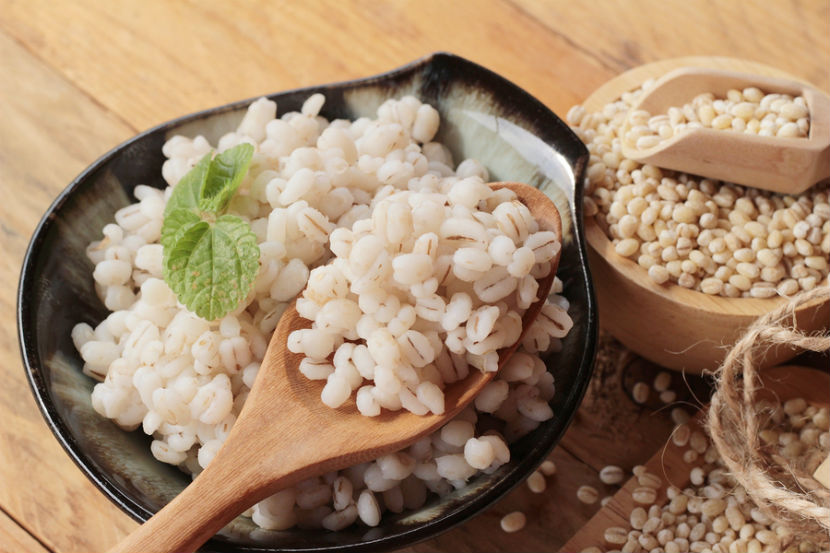
Barley is a delicious, fibre-rich ancient grain with a mild, slightly nutty taste and chewy texture. It’s often used in soups and stews, and it goes well in casseroles and salads too. Get tips to buy, store and enjoy this easy, nutritious and budget-friendly grain.
Types of barley
Barley kernels
- Whole grain barley has all three parts of the grain kernel (the bran, endosperm and germ). Since whole grain barley has these three parts, it is higher in fibre and has more vitamins, minerals and phytonutrients than refined grains. Only the hull (outer layer) is polished or scrubbed off. It’s also called hulled, hulless or dehulled barley
- Pot or scotch barley has been polished a bit further so it cooks quicker. It’s also a whole grain
- Pearl barley has been polished one step further. It does not have the bran layer so it’s not a whole grain.
Barley flakes are made with whole grain barley. The barley is steamed, rolled flat and dried, similar to rolled oats. Barley flour can be made from whole grain or pearl barley. It has a light golden colour and slightly nutty taste.
Nutrition
Barley is nutritious. It is rich in soluble fibre, which helps lower blood cholesterol and control blood glucose levels. Barley also contains insoluble fibre, which helps with regular bowel movements. Barley provides a variety of vitamins, minerals and antioxidants. It is low in fat, sodium and sugar. Whole grain barley and pot barley are whole grains and more nutritious than pearl barley. However, all types of barley are a good choice because the soluble fibre in barley is found in the entire grain and not only in the outer bran layer.
Buying local barley
Barley is Canada’s third largest crop after wheat and canola. Look for Product of Canada on food packaging to find out if barley is locally produced. Buying Canadian foods supports the Canadian economy and our farming families.
Buy it best
Pot and pearl barley can be found in most grocery stores near the dried beans section. If you can’t find whole grain barley, barley flakes or barley flour at the grocery store, try a bulk or health food store.
Tips for storing barley
Uncooked barley should be stored in an airtight container. It will keep in a cool, dry place such as a pantry for up to one year. Cooked barley should be stored in an airtight container. It will keep in the fridge for 3-5 days or in the freezer for one month.
Tips for using barley
- There is no need to rinse barley before using it.
- To enhance the flavour of barley, heat the kernels in a skillet for a few minutes or cook it in broth instead of water.
- Save time. Cook extra barley & freeze it. Add it to soups or salads.
- Use pot or pearl barley interchangeably in recipes.
Tips for cooking barley
- Cooking pot or pearl barley on the stove is easy. Bring the barley and liquid to a boil, cover and simmer for 40-55 minutes. Whole grain barley takes 75-90 minutes to cook.
- Cooked barley will absorb liquids even after cooking. If a dish thickens, add broth or water.
- For salads and pilafs where it’s preferable for the cooked grain to separate easily (as opposed to sticking together), use 2 parts liquid to 1 part barley. If the grains are sticky, rinse well with boiling water.
- For risottos and soups with a creamier texture, use 3 parts liquid to 1 part barley.
- Barley can be cooked in a rice cooker, just like rice.
5 things to do with barley
1. For variety, use barley instead of rice in recipes
Try it in cabbage rolls, pilafs, soups, stuffing, side dishes and salads. Give this beet and barley salad a try!
2. Try barley at breakfast
- Enjoy barley as a hot cereal. Heat leftover plain barley with fortified soy beverage or milk or use barley flakes. Top with any fruit, nuts or seeds on hand.
- For a hearty breakfast, top leftover barley with a fried egg.
3. Bake with barley flour
- Replace ½ the all purpose flour with barley flour in muffin, pancake, scone, waffle and quick loaf recipes. If you find the batter is a bit dry, you can add some more liquid.
- For yeast breads, replace ¼ of the all purpose flour with barley flour.
4. Use up leftovers to make a hearty barley soup
Try one of these combinations or make up your own:
- Beef, mushrooms, onions, frozen green peas, sage, pepper, barley
- Green lentils, celery, carrots, kale, onions, thyme, lemon, pepper, barley
5. Make a tasty side dish
Add any of the following to cooked barley:
- Slivered almonds and chopped dried apricots
- Lemon zest, grated parmesan cheese, chopped sautéed kale
- Sliced cooked mushrooms and chopped parsley
How can a dietitian help?
Dietitians can support you throughout many phases of your life, from pregnancy to eating well when you are older. Counselling sessions with a dietitian can also help you to prevent and treat health conditions like diabetes and heart disease. Your dietitian will work with you to give you personalized advice that meets your lifestyle and goals.
Connect with a dietitian today!
Bottom line
Barley is a nutritious choice to add to any meal. It has fibre, antioxidants and many vitamins and minerals. It has a great nutty flavour that goes well in soups, stews, salads and as a side dish. Choose whole grain barley for added nutrition.
You may also be interested in:
Choosing Whole Grains FAQ
Facts on Soluble Fibre
Top 5 Reasons to See a Dietitian
This article was written and reviewed by dietitians from Dietitians of Canada.
Last Update – May 6, 2022